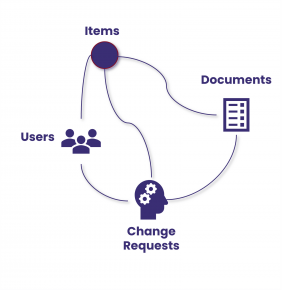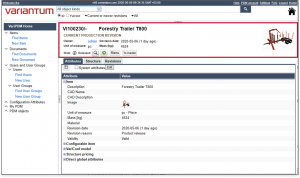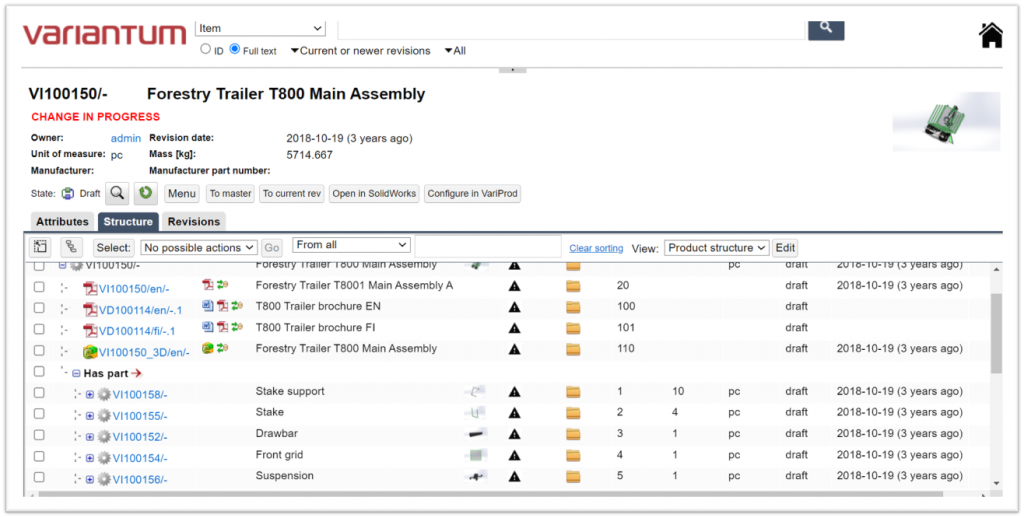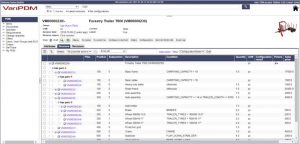Key Terms & Basic Concepts
VariSuite
VariSuite is an unique Offering Management suite that combines product development, configure-price-quote, order-to-manufacture, installed base processes, and many other functionalities in one system.
VariSuite enables data usage between people and processes, inside or outside the company. It adapts to any company’s needs with dynamic data and a product model which provides companies with self-maintainability. VariSuite also supports configurable products, whether the products are simple or complex. The system is modular: modules work independently or together in the same database and share a common framework.
VariPDM
VariPDM is an out-of-the-box and easy-to-use PDM (Product Data Management) system with a product configurator. The implementation and basic setup can be done with your data in a few days.
The core system is designed to handle basic PDM functionalities from engineering to production.
VariPDM is very flexible and the data model changes can be done online with the admin tool.
VariPDM can be used inside and outside companies thanks to its flexible user access mechanism.
Personalization is managed by the user or key user.
VariPDM has integrations with MS Office and most CADs and systems like ERP.
VariPDM is scalable and extendable to VariSuite.
Objects
In VariSuite most data is stored as different kinds of objects. An object can, for example, be an item, a document, a user, or a change request.
Object Master
Object master level manages common attributes for the object. It defines flexible access and visibility rights for all revisions, users, user groups, and roles.
It also has its own Master Lifecycle:
![]()
Object Revision
Some objects, like Items and documents, can have revisions. Revisions control the changes done to the object and revisions have their own life cycle separate to master level lifecycle.
For example, revisions and revision control support the item release management process.
There may be many revisions of an item.
- Revision A, Released (Old)
- Revision B, Released (Current Production)
- Revision C, Draft (In Design)
Each one of the revisions will follow the following lifecycles.
![]()
Attributes
In VariSuite database, attributes represent the characteristics or properties that define a database object. For instance, a user can have several attributes such as description, email address, user roles, etc.

Items
Items describe material management objects e.g. assemblies, components, parts, or any level Item type objects that help capture a complete product definition, for example, a complete trailer.

Documents
Documents are database objects that can be imported or created directly in VariSuite. They contain files and are typically connected to items. Documents have master, revisions, language variants and minor versions. Master manages common attributes and access rights. They can be reusable and are easy to find.
Users, User Groups, and Roles
Roles, users, and user groups define the access to the product data: read, write, modify and promote.
- User: VariPDM allows user creation to grant people access to the product data. A user can belong to several groups and have several roles assigned.
- User groups: Users can be organized into groups or sub-groups to control efficiently the access to the product data.
- Roles: The system roles are defining the basic access & permission rights to the related user. Some roles are administrator, user manager, access manager, item reader, document writer, etc.
Change Request
A change request (CR) is an object to report and manage changes. The change process gathers information on all related items, documents, and other change requests as one package to manage the whole change process.
BOM Management
A bill of materials (BOM) is a list of the assemblies, components, raw materials, parts, and the quantities needed to make an end product.
The structure view allows you to see several levels of the assemblies simultaneously.
You can see an example of a BOM in VariSuite below. You can see both items and documents.
Product Structure and Product Model
The product structure consists of items, documents, and rules organized in a structural way. It represents a physical product organized in modules or assemblies and contains information such as engineering details, drawings, technical specifications, CAD details, painting instructions, service products, software, etc.
A product structure describes different relations between objects and it can be used as a product model to cover different configuration parameters, rules, modules, components, and documents to fulfill customer demands.
VariClient and VariWeb
VariSuite users access the system through the Web interface or through the graphical client program, called VariClient.
VariWeb is a browser application, which allows users to read data and modify data in somewhat restricted way.
VariClient runs in a user’s workstation. It is mainly used for administration tasks, such as for adding new users, and for the manipulation of configurable product models.
VariSuite data is mainly stored in a database and in a document vault. The document vault stores the contents of document files, and the database contains all other data, such as objects, relationships, and their attributes.
CRM, ERP, CAD and other Integrations
With open APIs, VariSuite can be integrated into any system, like CRM (e.g. Salesforce) or ERP systems (e.g., SAP, MS Dynamics AX, and IFS).
VariSuite has standard integration options to MS Office and most CAD systems as well (Creo, Solidworks, Inventor, and AutoCAD Mechanical).
Additional custom integrations can be created using open API. A separate configuration team is not needed.
MS Office Integration
With the straightforward MS Office integration, you can easily work with documents from MS Office applications with VariSuite.
You can search, create, or edit MS office files with ID, attributes and properties, revisions, versions, locking, and link documents to existing items or other objects.
The supported applications are Word, Excel, PowerPoint, and Outlook.
The installation can be done with any Windows PC with the VariPDM MS Office plug-in.
Configurable Products
Configurable products are those that can be defined up to a certain extent by the customers’ requirements.
For example, for a forestry trailer you could choose, among a pool of payload options, rare wheels or if you want the trailer to include a toolbox or not.
Non-Configurable Products
Non-configurable products are those which configuration cannot be adapted to the customers’ requirements at any level.
The product is configured in one way and cannot be customized.
Offer Template
The offer template is a document template that VariSuite’s CPQ offers to simplify the process of creating an offer. In the VariSuite interface you can access the form you have to complete to create the offer.
The content of the template can be edited from the admin interface and allows you to adjust and configure the offer to your product offer standards.
Product Configuration
Product Configuration is the process of customizing a product to meet the needs of a customer.
A product configuration tool is usually included as a part of Configure-Price-Quote (CPQ) software and allows customers and sales reps to configure products themselves.
Tekniikantie 4 A (Aallonharja Business Park)
02150 Espoo, Finland
Sales +358 10 425 9100



